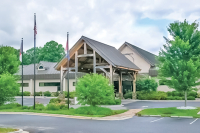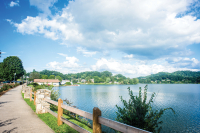Wrinkles in space and time
 Millions of years ago America and Africa rubbed shoulders and the Appalachian Mountains were created. The ancient Appalachians, at one time as high as the Alps or Rockies, created quite an east-west barrier from Canada down to central Alabama. Today’s kinder, gentler Appalachians eroded and for the most part still impact us in myriad ways. A lot of it has to do with weather. As most of our weather patterns come from the west, we on the east side of the Appalachians often have to wait and see what we get.
Millions of years ago America and Africa rubbed shoulders and the Appalachian Mountains were created. The ancient Appalachians, at one time as high as the Alps or Rockies, created quite an east-west barrier from Canada down to central Alabama. Today’s kinder, gentler Appalachians eroded and for the most part still impact us in myriad ways. A lot of it has to do with weather. As most of our weather patterns come from the west, we on the east side of the Appalachians often have to wait and see what we get.
I remember learning about rain shadows caused by the mountains. Asheville is in one — it’s actually the driest city in the state. That is why they moved Asheville’s official weather station out to the airport, where it would be more representative of the area. When moisture-laden air comes from the west-southwest, it hits the mountains. It leaves a lot of moisture on the west side, but when it tops the mountains it gets a little bump and skips over Asheville before dumping the moisture a little bit farther east or north.
I recently learned about another weather phenomenon generated by our mountains from a post on FaceBook by the Great Smoky Mountains Association (GSMA).
It was a video showing a lenticular cloud over Clingmans Dome. I had never heard of a lenticular cloud. The most common way lenticular clouds are formed is when fast moving dry stable air crosses a mountain barrier. The air hits the windward side of the mountain and rises in layers. The air cools as it rises and if the temperature reaches the dew point it condenses and forms a cloud. These clouds are named depending on the altitude of the atmosphere where they form. Stratocumulus lenticularis are formed in the lower level of the atmosphere; altocumulus lenticularis (most common) are formed at mid-level altitudes and cirrocumulus lenticularis are formed at higher altitudes. The name “lenticularis” refers to the lens-shaped appearance of these unique clouds. If it is a large mass of air bumping the mountain it is pushed up in waves and the waves will stack up creating a “wave cloud.”
Lenticular clouds are often thought of as stationary, but that’s not really the case. As the air spills over the mountain and starts down the leeward side it warms back up and dissipates, while the air on the windward side is still rising and condenses. The zone where the cloud is created remains stationary, but the air continues to pass through.
Related Items
According to the GSMA post, the winds in this cloud were probably around 50 to 60 mph. “This particular lenticular had extreme turbulence and a strong rotating rotor cloud at its base. Being on the Dome this morning would have been like being in a mild chilly wind tunnel.”
Lenticular clouds are more prevalent in the West, probably due to higher mountains and more dry, stable air. In the weird but true category, the lens or saucer shape of these clouds — plus the fact that they often seem stationary — makes them prime suspects for UFO sightings. Another bit of lenticular trivia — pilots of powered aircrafts avoid lenticular clouds because of the turbulence associated with them. Glider pilots, on the other hand, seek them out because the “lift” associated with them can really give a glider a boost.
To see some wonderful pictures of lenticular clouds check out www.environmentalgraffiti.com/nature/news-20-most-incredible-lenticular-clouds?image=0.
(Don Hendershot is a writer and naturalist. He can be reached a This email address is being protected from spambots. You need JavaScript enabled to view it..)









